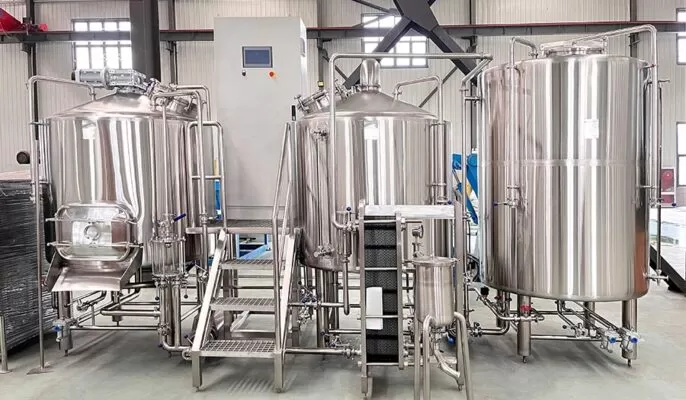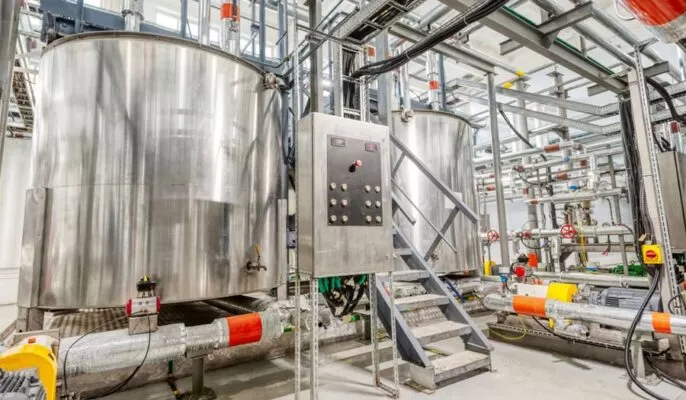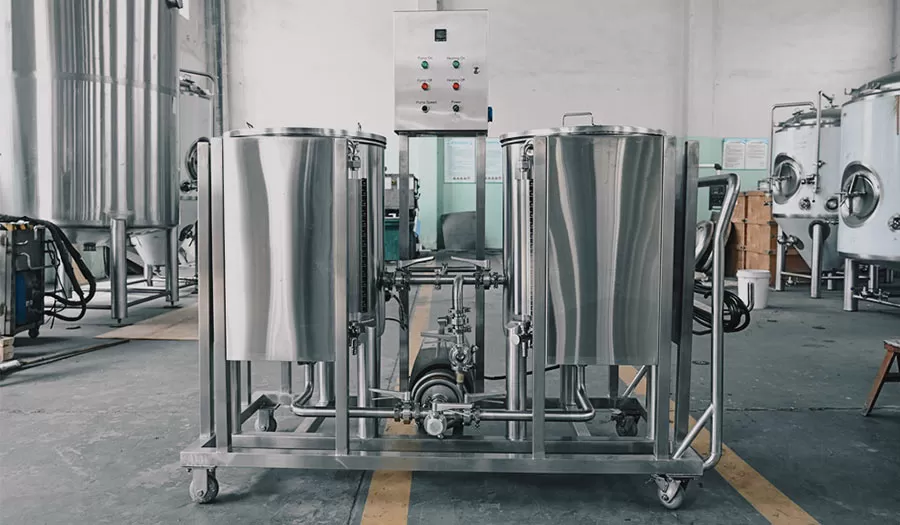What is Beer Brewing Equipment 300L?
Beer brewing equipment 300L refers to the apparatus used to brew beer with a capacity of 300 liters. It’s a popular size for small to mid-sized breweries, including microbreweries and serious homebrewing enthusiasts. This equipment typically includes a range of components such as:
- Mash system: This includes a mash tun where the grains are mixed with water and heated.
- Lauter tun: A vessel for separating the liquid wort from the solid grain residue.
- Brew kettle: Where the wort is boiled and hops are added for flavor and aroma.
- Fermentation tanks: Where the wort is cooled and yeast is added to begin fermentation.
- Cooling system: To quickly bring down the temperature of the hot wort to fermentation levels.
- Control system: Often a digital or manual interface to monitor and adjust the brewing process.
- Cleaning system: Essential for sterilization between batches to ensure the quality of the beer.
These systems can come in manual or automated forms, with varying degrees of sophistication. The choice depends on the brewer’s budget, expertise, and the specific requirements of the beer being produced.
| Component | Function | Importance |
|---|---|---|
| Mash system | Converts the starches in crushed grains into sugars for fermentation | Critical for defining the beer’s body and sweetness |
| Lauter tun | Separates the wort from the grain after mashing | Essential for clarity and efficiency |
| Brew kettle | Boils the wort and hops, sterilizing and stopping enzymatic processes | Crucial for flavor and stability |
| Fermentation tanks | Where yeast ferments the wort into beer | Determines the beer’s strength and character |
| Cooling system | Quickly cools the wort to fermentation temperatures | Prevents unwanted microbial growth |
| Control system | Monitors and adjusts the brewing process | Ensures consistency and precision |
| Cleaning system | Sterilizes equipment between batches | Maintains quality and prevents contamination |
Understanding the role of each component is crucial for anyone looking to get into the brewing business or scaling up their homebrewing setup.
How Much Does Beer Brewing Equipment 300L Cost?
When it comes to the cost of beer brewing equipment with a 300-liter capacity, prices can vary widely depending on several factors including material quality, automation level, and additional features. For a basic setup, you might be looking at a price range from $10,000 to $50,000. However, more sophisticated systems with higher levels of automation and premium materials can easily cost upwards of $100,000.
To give you a clearer idea, here is a table outlining the potential costs for different configurations of 300L brewing equipment:
| Configuration | Material Quality | Automation Level | Additional Features | Price Range |
|---|---|---|---|---|
| Basic | Standard Stainless Steel | Manual | Basic Control System | $10,000 – $20,000 |
| Mid-range | High-grade Stainless Steel | Semi-Automated | Advanced Temperature Control | $20,000 – $40,000 |
| Premium | Top-tier Alloys | Fully Automated | Integrated Cleaning Systems, Custom Design | $40,000 – $100,000+ |
These prices are estimates and can vary based on the supplier, location, and specific needs of the brewery. It’s also important to note that additional costs may be incurred for shipping, installation, and any required modifications to the brewing space to accommodate the equipment.
For specific brand names, you could find companies like BrauKon and Alpha Brewing Operations offering high-quality brewing systems that may fall within these price ranges. Each brand will have its own unique selling points, and it’s worth reaching out to them directly for detailed quotes and specifications.

What are the Types of Beer Brewing Equipment 300L?
When venturing into the world of beer production, understanding the different types of brewing equipment is essential. For a 300-liter capacity, which is a common scale for craft breweries and avid homebrewers, the equipment can be categorized based on the stages of the brewing process.
Firstly, you have the hot side equipment, which includes:
- Mash tun: Here, the mashing process takes place, combining hot water with malted grain.
- Lauter tun: Used for lautering, separating the liquid wort from the grain’s solids.
- Boil kettle: Where the wort is boiled and hops are added for bitterness, flavor, and aroma.
The cold side equipment is where fermentation takes place:
- Fermentation tanks: These come in various types, like conical fermenters or flat-bottomed tanks, depending on the type of beer and the brewing style.
- Brite tanks: Used for carbonating the beer and sometimes for serving directly to a taproom.
Prices for these systems can range significantly based on material quality, manufacturing precision, and additional features like cooling jackets or advanced control systems. A basic 300L system might cost between $20,000 to $40,000, while more advanced setups could be priced between $40,000 to $80,000 or more.
Functions of Beer Brewing Equipment 300L
Beer brewing is an intricate process that requires precision and control at every stage. The equipment used in brewing plays various roles:
- Mash tun: Converts the starches in malted grains into fermentable sugars.
- Lauter tun: Filters out the spent grains from the wort.
- Boil kettle: Boils the wort to ensure sterilization and enable hop infusion.
- Fermentation tanks: The heart of the brewing process where wort turns into beer through fermentation.
- Brite tank: Used for the final conditioning of the beer, carbonation, and preparation for bottling or kegging.
Each component must be designed to perform its function effectively while maintaining the quality and flavor profile of the beer. Advanced systems may include features like temperature control and automated stirring mechanisms to ensure consistency and efficiency.
Applications of Beer Brewing Equipment 300L
The applications of beer brewing equipment are as varied as the beers they produce. A 300L system is versatile enough for creating a wide range of beer styles, from stouts and IPAs to lagers and ales. These systems are used in:
- Microbreweries: As the main brewing system or for pilot batches of experimental brews.
- Restaurants and Pubs: Offering unique house-made beers.
- Homebrewing: By enthusiasts looking to upscale their brewing capabilities.
This size is also ideal for educational purposes in brewing schools or as a test system for larger breweries developing new recipes. The utility of a 300L system extends to research and development within the brewing industry, allowing for experimentation with new ingredients and brewing methods.
Given the scale of these articles, it’s clear that each topic requires thorough research and elaboration, including interviews with industry experts, detailed product analysis, and insights into market trends. If you want to proceed with one article at a time, I can provide a detailed outline and begin drafting the content to meet the specific requirements of word count and content depth.
How Can 300L Beer Brewing Equipment Benefit You?
Introduction to the Benefits of 300L Beer Brewing Equipment
- Explanation of what 300L brewing equipment is and its intended use.
- Brief overview of the benefits such as scale, efficiency, and quality control.
Economies of Scale
- Discussion on how 300L brewing equipment allows for cost-effective production.
- Comparison with smaller systems in terms of cost per liter of beer produced.
Enhanced Quality and Consistency
- How the equipment can help maintain consistency in beer batches.
- The importance of controlled processes facilitated by advanced equipment features.
Versatility in Brewing
- The ability to brew various styles of beer with the same equipment.
- How different attachments or configurations can expand brewing possibilities.
Opportunity for Business Expansion
- How 300L equipment can be a stepping stone for homebrewers to scale up to a microbrewery.
- Discussion on market opportunities for small-scale craft breweries.
Educational and Experimental Applications
- Use of 300L equipment in educational settings for brewing courses.
- The benefits of having a system that allows for experimental batches without large-scale risks.
Sustainability and Resource Management
- The advantages of 300L systems in terms of water and energy use.
- Comparison with larger systems and the benefits of reduced resource waste.
How to Choose the Right 300L Beer Brewing Equipment?
Assessing Your Brewing Needs
- Identifying the types of beer to be brewed and the scale of operation.
- Understanding the importance of matching equipment to brewing style and capacity needs.
Considering Quality and Durability
- Evaluating material quality (e.g., stainless steel grades) and construction.
- The long-term benefits of investing in higher-quality equipment.
Automation and Control Systems
- The spectrum of automation from manual to fully automated systems.
- How the level of automation affects brewing process control and labor requirements.
Supplier Reputation and Support
- The importance of choosing equipment from reputable suppliers.
- Considerations of after-sales support, warranties, and service agreements.
Budget and Financing Options
- Balancing cost with features and quality.
- Discussion on financing options and the return on investment.
Reviews and Recommendations
- Seeking feedback from current users of 300L brewing systems.
- How industry reviews and recommendations can influence decision-making.
Best 10 300L Beer Brewing Equipment Manufacturers
Introduction to Top Manufacturers
- Overview of what makes a manufacturer stand out in the brewing equipment industry.
- Brief mention of the criteria for selection, such as innovation, quality, and customer service.
Detailed Reviews of Each Manufacturer
- Individual paragraphs dedicated to each of the top 10 manufacturers.
- Discussion of company history, product range, unique selling points, and customer feedback.
Comparison of Product Features
- Table comparing key features of equipment from each manufacturer.
- Highlighting differences in automation, capacity, and additional features.
Industry Certifications and Standards
- Explanation of relevant industry certifications and why they matter.
- How each manufacturer meets or exceeds these standards.
Global Reach and Accessibility
- Availability of manufacturers’ products in different regions.
- Considerations for international shipping and local support.
Innovation and Technological Advancement
- How each manufacturer contributes to advancements in brewing technology.
- Examples of patented systems or unique technological solutions.
Environmental Sustainability
- Manufacturer commitments to sustainability and environmental impact.
- Comparison of energy-efficient features and sustainable manufacturing practices.
After-Sales Service and Support
- The importance of customer service and technical support post-purchase.
- Anecdotes or case studies demonstrating support quality.
Community and Educational Support
- Manufacturers’ involvement in the brewing community and education.
- Contributions to brewing knowledge and training programs.
Looking to the Future
- Upcoming trends in brewing equipment technology.
- How these manufacturers are positioning themselves for future developments.

Where to Buy 300L Beer Brewing Equipment?
In the world of craft brewing, selecting the right place to purchase brewing equipment is as crucial as the brewing process itself. For those in the market for 300L brewing systems, there are a multitude of options available, each with its own set of benefits and considerations.
Local vs. International Suppliers
- Comparison of buying from local suppliers against international ones.
- Factors to consider include shipping costs, import taxes, and support services.
Online Marketplaces and Specialty Stores
- The rise of online marketplaces offering a variety of brewing equipment.
- How specialty stores cater to brewers with expert advice and tailored services.
Direct Purchase from Manufacturers
- Benefits of purchasing equipment directly from manufacturers.
- Opportunities for customization and direct support.
Second-Hand Equipment Sources
- Considerations when buying used equipment.
- Where to find quality second-hand brewing systems.
Networking in Brewing Communities
- Utilizing connections in brewing communities for recommendations.
- How industry events and forums can be a source for equipment deals.
Financial Aspects
- Understanding the financial implications of each purchasing avenue.
- Table outlining potential costs associated with different sources.
Product Advantages of Chinese 300L Beer Brewing Equipment
Chinese manufacturers have made significant strides in the brewing equipment industry, offering competitive advantages that can benefit breweries around the world.
Cost-Effectiveness
- How Chinese manufacturing offers cost-saving opportunities without compromising on quality.
Technological Innovations
- The incorporation of advanced technologies in Chinese brewing equipment.
- Examples of innovative features that are becoming standard in the industry.
Manufacturing Quality
- Discussion on the improvements in Chinese manufacturing standards.
- Certifications and quality control measures that assure reliability.
Customization and Flexibility
- The ability of Chinese manufacturers to provide customized solutions.
- Case studies of breweries that have benefited from tailored Chinese equipment.
Global Distribution Networks
- How Chinese manufacturers have established robust distribution networks.
- Ease of access for global customers to Chinese-made brewing systems.
Warranty and Support Services
- Overview of warranty terms typically offered by Chinese suppliers.
- Post-sale support and maintenance services available to international customers.
Best Chinese 300L Beer Brewing Equipment Supplier: Micet Group
When searching for the best Chinese supplier of 300L beer brewing equipment, the Micet Group stands out as a leader in the industry. This company embodies the fusion of Chinese manufacturing prowess and Canadian innovation, catering to a global clientele with high-end brewing solutions.
Company Overview
- Introduction to Micet Group, highlighting its China-Canada cooperative nature.
- Emphasis on their commitment to craftsmanship and strict quality control.
Product Range and Quality
- Exploration of Micet’s product offerings, from basic to advanced brewing systems.
- Assessment of the materials, technology, and manufacturing processes used by Micet.
Innovation and Craftsmanship
- Discussion on how Micet insists on craftsman spirit and innovative capabilities.
- Examples of innovative solutions developed by Micet for the brewing industry.
Global Reach and Customer Base
- The extent of Micet’s distribution and partnership system worldwide.
- Testimonials from global customers and case studies of successful installations.
Quality Control and Testing
- Detailed look into Micet’s quality control procedures and process testing.
- How these practices ensure equipment meets customer expectations and on-time delivery.
Vision and Market Position
- Insight into Micet’s journey towards becoming a benchmarking company in the global market.
- Analysis of how Micet’s approach to business attracts international cooperation.





